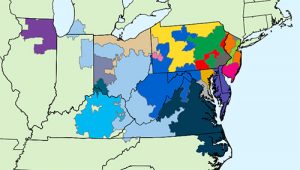A “multi-post” that I rarely ever do any more. But this issue is important so first my recommendations, first published on Facebook, and then the facts on the ground.
CWLP IS Doomed
If the members of the City Council of Springfield had any sense at all (and guts/leadership) they would:
1/ Tell IBEW 193 to retrain the workers at Dallman 1 2 and 3 in Solar and Wind
2/ They would close Dallman 1 2 and 3
3/ They would put out a notice for proposals to gasify Dallman
4/ They would take the savings and invest it in renewables
5/ They would ask the County to drop their ridiculous zoning rules for wind farms so we could have a wind farm in Sangamon county
But instead they will live in the 1900s and like Trump demand coal for a fuel source no matter what.
First the SJ-R
https://www.sj-r.com/news/20190507/report-recommends-cwlp-retire-its-three-oldest-power-units-move-away-from-coal
Report recommends CWLP retire its three oldest power units, move away from coal
In a much-anticipated report, an energy consulting firm is recommending that City Water, Light and Power retire three of its four coal-fired power generators “as soon as feasible” while offering the utility a roadmap to a less coal-dependent future.
The Energy Authority (TEA), which was retained by the city last year to map out a plan for the utility’s power generation for the next 20 years, released the 84-page “integrated resource plan” on Monday and gave a presentation to members of the Springfield City Council.
The firm recommended that CWLP retire Dallman units 1, 2 and 3 by as early as 2020 after finding that “no scenario economically retained these units.”
The results are not much of a surprise given the age of the units and the current state of the energy market, which has been upended by the rise of natural gas and the increasing affordability of renewable energy. For coal-dependent utilities like CWLP, it has not been easy to keep up.
“One of the things that we’ve been saying for quite some time is that coal-fired units basically can’t compete very well in the market, they’re not competitive in the current market,” said CWLP chief utility engineer Doug Brown. “So this report basically confirms all of that.”
Then the Illinois Times.
https://illinoistimes.com/article-21209-consultant-retire-three-of-cwlp%E2%80%99s-coal-fired-plants.html
Thursday, May 9, 2019 12:05 am
Consultant: Retire three of CWLP’s coal-fired plants
How can Springfield’s City Water, Light and Power (CWLP) best provide electrical power to meet the community’s future energy needs? Retiring Dallman Units 1, 2 and 3 coal-fired plants, increasing the use of renewable energy and expanding energy efficiency are some of the recommendations included in a recently released report.
Last year the city hired The Energy Authority (TEA) to develop an Integrated Resource Plan (IRP). Kevin Glake from TEA presented the results of the comprehensive study to the city council on May 6 at a meeting of the Public Utilities Committee. Anyone who uses electricity generated by CWLP or cares about the future of the city’s public utility should be interested in this plan.
Public comments are being accepted now through June 3, and a public open house is scheduled for 5-7 p.m. May 20 at the Lincoln Public Library. More information and the complete plan are available online at https://cwlp.com/IRP.aspx. Comments can be emailed to IRP@cwlp.com or mailed to CWLP General Office, ATTN: CWLP IRP, 800 E. Monroe St., Springfield, 62701.
https://illinoistimes.com/article-21312-letting-go.html
Thursday, June 13, 2019 12:19 am
Springfield ponders cutting back on coal
t’s not a welcome message in council chambers.
“They came back with exactly what everyone on the city council knows,” Ward 1 Ald. Chuck Redpath declared at a May 28 committee-of-the-whole meeting, joining colleagues in criticizing the report issued by The Energy Authority. “The point is, we can’t just…go down without a fight. We’re talking about getting rid of two, maybe three, of our plants, and it’s going to be detrimental to our ratepayers. It’s going to be detrimental because, eventually, you are going to have to go out on the net, and buy off the net – the grid – and then we’re going to be subjected to whatever prices we get stuck with if we’re down to one plant. We’ve got to start thinking outside the box and find a better way.”
And so Redpath and other aldermen cling to coal, even as they talk about new courses. Those opposed to coal have a simple response to complaints about a report that contains no surprises.
“They’re not learning anything new because nothing has changed in six years in terms of the economics of those old units,” says Andy Knott, senior campaign representative for the Sierra Club. “They don’t want to look at the facts and the reality and make the best decisions for the ratepayers.”
“They’re too old”
“Integrated resource plan,” a tag invented in the 1980s, is the official title of the study that’s drawing ire from aldermen. The planning process is supposed to help utilities figure out long-term economics. Thirty-three states, but not Illinois, require utilities to prepare IRPs that are subject to review by state regulators.
:}
Go there and read sadly/ More next week…
:}



